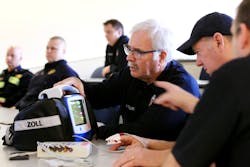Delivering high-quality patient care in the out-of-hospital environment requires an evidence-based medical protocol, continuing education that’s focused on improving patient outcomes and a robust quality-improvement program.
These three pillars of EMS are interrelated and synergistic. An effective continuous quality improvement (CQI) program identifies systemic issues within an agency and helps to refine medical protocol and education. Ultimately, such a CQI program might lead to improved patient outcomes, decreased risk for your agency and improved satisfaction of personnel.
CQI case
Let’s say that your agency receives a complaint about an IV line that infiltrated with dextrose while treating a patient. Initially, your thought process is focused on the personnel who were directly involved with the patient interaction. Was the IV placed in the right location? Did personnel confirm patency of the IV before the administration of dextrose?
You also consider any systemic issues that might have led to the error. You are able to collect and analyze data from patient encounters, review your medical protocol, and evaluate your initial and continuous education material. Through this process, you realize that your medical protocol doesn’t require a saline flush following IV placement. Furthermore, your training material doesn’t address this topic either.
You collaborate with your medical director to update your IV procedure protocol. You also work with your education coordinator to update the agency’s training materials. In this case, a bad outcome leads to improvements in your agency. However, is there a more proactive mechanism for identifying systemic issues in the agency?
Focus areas for CQI
Consider the following four CQI categories that are pertinent to the prehospital setting: time-critical diagnoses, high-risk patient encounters, dispatch and response operations, and special operations.
Common time-critical diagnoses include cardiac arrests, ST-elevation myocardial infarctions (STEMI), strokes, trauma and sepsis. Other emergent encounters that are important for an EMS agency to review include seizures, diabetic emergencies, anaphylaxis and respiratory distress. Key performance indicators for these runs typically focus on clinical and operational metrics as well as patient outcomes.
High-risk patient encounters are best identified by your agency and associated stakeholders. However, commonly reviewed encounters include patient refusals, nontransports, 72-hour call backs, behavioral emergencies, pediatric patients, ALS procedures and undifferentiated dispatch types. CQI review of these run types might detect sentinel events that lead to in-depth reviews of protocol and standard operating procedures. By focusing a part of your CQI program on high-risk patient encounters, patient care will be improved, risk will be reduced and your personnel will be protected.
Although not traditionally considered in medical quality improvement initiatives, dispatch and response represent important areas for fire-based EMS agencies. The ability to correctly triage call types and assure appropriate response modes might have a significant effect on patient outcomes. Your dispatch process also might be indirectly involved in patient care. For example, dispatch-assisted chest compressions might increase the rate and quality of bystander cardiopulmonary resuscitation. Your EMS agency’s dispatchers also might be able to help parents or guardians to administer epinephrine to an unstable patient who is experiencing anaphylaxis.
Lastly, special operations, such as community paramedicine, vaccine administration, naloxone distribution, tactical EMS and hazmat operations, require adjusted approaches to the CQI process. As the scope of fire-based EMS evolves, it’s imperative for CQI programs to adjust to some of these unique roles.
A simplified process for CQI
The literature in regard to CQI is quite extensive, to say the least. However, fire-based agencies can focus on a simple, five-step approach to EMS CQI: identify, collect, analyze, implement and reassess.
EMS agencies can consider the four categories of patient encounters and determine pertinent variables to collect and analyze. The collection of variables might occur through individual chart review or might be obtained from summary reports that utilize functions in electronic patient care reporting software. Special attention is needed to collect clinical information in a format that facilitates meaningful analysis.
Analyzed data then can be used to implement changes in protocol and continuing education on a systemic level. Any changes that are implemented should be reassessed at determined intervals to monitor improvement and to detect residual issues. This process also facilitates CQI at the individual level by providing information for performance improvement plans and remediation strategies.
Putting It All Together
Developing and implementing a continuous quality improvement (CQI) process for fire-based EMS is best achieved through adequate planning and preparation. Reviewing every patient encounter often is unfeasible and unnecessary. A CQI program can be tailored to meet organizational needs and resources by prioritizing patient encounters and being proactive. For example:
Requiring 100 Percent Review
Patient nontransports and death within 72 hours, hospital quality concerns and patient complaints might be associated with increased medicolegal risk, so having a well-defined CQI process helps to mitigate risk for your agency. When individuals who are outside of your organization raise concerns, a well-defined CQI process helps with documentation and compliance.
Requiring Perpetual Review
Patient encounters that require perpetual review focus on documentation and ALS procedures. An organization can determine the percentage of patient encounters to review each month. Reviewing documentation focuses on a high-frequency skill that can help to improve patient safety, quality of care and risk reduction. ALS procedures typically reflect low-frequency, high-risk events in critically ill patients and, therefore, are important to review on a regular basis.
Other Patient Encounters
An organization also might choose to focus on designated patient encounters throughout the year (see Table 1). Each year the plan can be updated to substitute different types of patient encounters, depending on the needs of your agency.
About the Author
Eric Cortez
Dr. Eric Cortez is a fellowship-trained and board-certified EMS physician who practices emergency medicine in Columbus, OH. He serves as a faculty member for the OhioHealth Doctors Hospital Emergency Medicine Residency and EMS Fellowship Program as well as medical director for the OhioHealth System EMS Program and several EMS agencies in the region.
